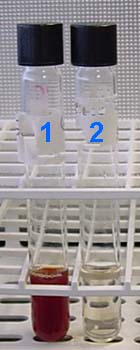
Nitrate Reduction
Some species of bacteria possess enzymes called nitrate reductases which allow them to anaerobically reduce nitrate. During the nitrate reduction process, nitrate is reduced to nitrite, which can then be reduced to ammonia, and finally to molecular nitrogen. Nitrate broth tubes, containing nitrate, peptones, and beef extract, are used to test for nitrate reduction.
Following incubation, two reagents are added: Nitrate Reagent A (sulfanilic acid) and Nitrate Reagent B (alpha-naphthylamine). These reagents test for the presence of nitrites, and the media will turn red if nitrites are present.
If no color develops, a pinch of zinc is added to the tube, which will reduce any nitrate remaining in the broth. If a red color appears, the organism is negative for nitrite reduction, because the zinc has reduced the nitrate to nitrite. However, if there is still no color change after the addition of zinc, this indicates the nitrates were reduced beyond nitrites to ammonia or molecular nitrogen, and the organism is positive for nitrate reduction.

After addition of Reagent A and Reagent B: Tube #1 is positive for nitrate reduction. The nitrate has been reduced to nitrite.

After addition of Zinc: This tube is negative for nitrate reduction. (The zinc reduced the nitrate, not the bacteria.)

After addition of zinc: This tube is positive for nitrate reduction. The bacteria have reduced the nitrate to ammonia or molecular nitrogen.